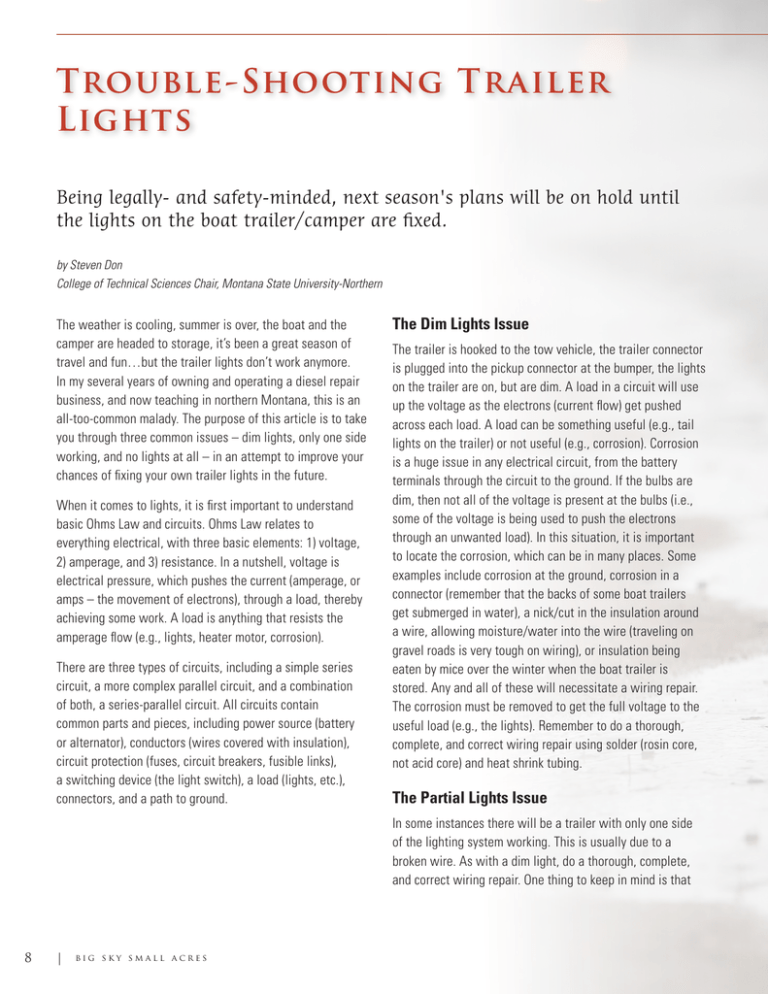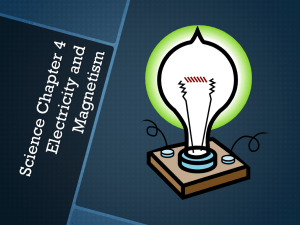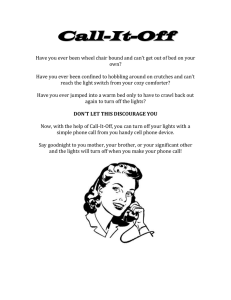Trouble-Shooting Trailer Lights
advertisement

Trouble-Shooting Trailer Lights Being legally- and safety-minded, next season's plans will be on hold until the lights on the boat trailer/camper are fixed. by Steven Don College of Technical Sciences Chair, Montana State University-Northern The weather is cooling, summer is over, the boat and the camper are headed to storage, it’s been a great season of travel and fun…but the trailer lights don’t work anymore. In my several years of owning and operating a diesel repair business, and now teaching in northern Montana, this is an all-too-common malady. The purpose of this article is to take you through three common issues – dim lights, only one side working, and no lights at all – in an attempt to improve your chances of fixing your own trailer lights in the future. When it comes to lights, it is first important to understand basic Ohms Law and circuits. Ohms Law relates to everything electrical, with three basic elements: 1) voltage, 2) amperage, and 3) resistance. In a nutshell, voltage is electrical pressure, which pushes the current (amperage, or amps – the movement of electrons), through a load, thereby achieving some work. A load is anything that resists the amperage flow (e.g., lights, heater motor, corrosion). There are three types of circuits, including a simple series circuit, a more complex parallel circuit, and a combination of both, a series-parallel circuit. All circuits contain common parts and pieces, including power source (battery or alternator), conductors (wires covered with insulation), circuit protection (fuses, circuit breakers, fusible links), a switching device (the light switch), a load (lights, etc.), connectors, and a path to ground. The Dim Lights Issue The trailer is hooked to the tow vehicle, the trailer connector is plugged into the pickup connector at the bumper, the lights on the trailer are on, but are dim. A load in a circuit will use up the voltage as the electrons (current flow) get pushed across each load. A load can be something useful (e.g., tail lights on the trailer) or not useful (e.g., corrosion). Corrosion is a huge issue in any electrical circuit, from the battery terminals through the circuit to the ground. If the bulbs are dim, then not all of the voltage is present at the bulbs (i.e., some of the voltage is being used to push the electrons through an unwanted load). In this situation, it is important to locate the corrosion, which can be in many places. Some examples include corrosion at the ground, corrosion in a connector (remember that the backs of some boat trailers get submerged in water), a nick/cut in the insulation around a wire, allowing moisture/water into the wire (traveling on gravel roads is very tough on wiring), or insulation being eaten by mice over the winter when the boat trailer is stored. Any and all of these will necessitate a wiring repair. The corrosion must be removed to get the full voltage to the useful load (e.g., the lights). Remember to do a thorough, complete, and correct wiring repair using solder (rosin core, not acid core) and heat shrink tubing. The Partial Lights Issue In some instances there will be a trailer with only one side of the lighting system working. This is usually due to a broken wire. As with a dim light, do a thorough, complete, and correct wiring repair. One thing to keep in mind is that 8 | big sky small acres this issue may require a splice in a section of wire. Ensure that the splice is the identical gauge (i.e., size of wire) as the existing wire because the gauge is specified for the current carrying-capacity of the circuit. If it is too small, there will be other issues. The No-Lights Issue The trailer light connector is plugged into the pickup connector at the rear bumper, the pickup lights are normal, but there are no lights on the trailer. The first place to check is the connector. Are all of the wires in place in the connector? Next, check the fuse. The fuse is one method of circuit protection (i.e., protects the electrical circuit from too much current) that protects the electrical system of the vehicle. Fuses come in many different forms (e.g., ATC, glass, mini, maxi, etc.) with different amperage ratings depending upon the circuit being protected. If the current flow exceeds the rating of the fuse, then the fuse will burn open (i.e., it will “blow”), therefore disrupting the flow of electrons. Without electron flow, the load in that circuit will not operate. PHOTO COURTESY OF BIGSTOCK.COM What causes a fuse to blow? Typically, a hot (electrified) wire touching a bare metal surface is the culprit. Before replacing any fuse, a diagnosis must be made as to why the fuse needs to be replaced. A common fallacy is that if a fuse blows, then it can simply be replaced with another fuse with a higher current rating. This can be done, but is a VERY BAD IDEA. Fix the problem, replace the fuse with the correct amperage rating, and avoid using homemade fuses and unsafe wiring. Be aware that with all of the above issues, a repair is being made because something is not as it should be (e.g., a wire is broken, the insulation around the wire is split allowing for corrosion, the fuse is blown). Something caused the issue and it is critical to diagnose the initial cause. For example, if gravel caused the broken wire, do I need to reroute the wire or place it inside a protective loom? If mice chewed through the insulation, do I need to re-evaluate my storage options? Making the fix without taking care of the initial cause will likely result in just a temporary fix. Take time to make the repair, do it right, and, do it only once. f a l l 2 0 1 5 | 9




